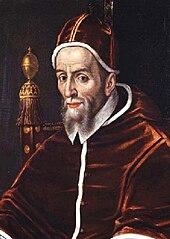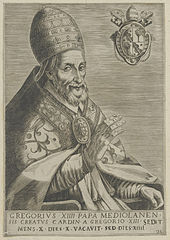Conclave October 1590
The conclave from October to December 1590 met after the death of Pope Urban VII († September 27, 1590 ) and met from to December 1590 in Rome . It lasted 60 days and elected Gregory XIV as Pope.
College of Cardinals
When Pope Urban VII died., Which was one of the College of Cardinals 65 cardinals.
Attendees
The 53 cardinals attending the conclave were:
- Giovanni Antonio Serbelloni , Cardinal Bishop of Ostia e Velletri , Cardinal Dean
- Alfonso Gesualdo , Cardinal Bishop of Porto e Santa Rufina , Cardinal Subdean
- Innico d'Avalos d 'Aragona OS , Cardinal Bishop of Frascati
- Marco Antonio Colonna seniore , Cardinal Bishop of Palestrina
- Tolomeo Gallio , Cardinal Bishop of Sabina
- Gabriele Paleotti , Archbishop of Bologna and Cardinal Bishop of Albano
- Girolamo Simoncelli
- Markus Sittikus of Hohenems
- Ludovico Madruzzo
- Michele Bonelli OP
- Antonio Carafa
- Giulio Antonio Santorio
- Girolamo Rusticucci
- Nicolas de Pellevé , Archbishop of Sens
- Gian Girolamo Albani
- Andreas of Austria , Bishop of Brixen and Constance
- Pedro de Deza
- Giovanni Vincenzo Gonzaga , O.Hosp.S.Joh.Hieros.
- Giovanni Antonio Facchinetti de Nucce .
- Alessandro Ottaviano de 'Medici , Archbishop of Florence
- Giulio Canani , Bishop of Adriatic
- Niccolò Sfondrati , Bishop of Cremona
- Antonmaria Salviati
- Agostino Valier , Bishop of Verona
- Vincenzo Lauro
- Filippo Spinola
- Simeone Tagliavia d'Aragonia
- Scipione Lancellotti
- Francesco Sforza
- Alessandro Damasceni Perretti
- Giovanni Battista Castrucci , Archbishop of Chieti
- Ippolito de 'Rossi , Bishop of Pavia
- Domenico Pinelli senior
- Ippolito Aldobrandini seniore , cardinal major penitentiary
- Girolamo della Rovere , Archbishop of Turin
- Girolamo Bernerio OP, Bishop of Ascoli Piceno
- Antonio Maria Gallo , Bishop of Perugia
- Costanzo as Sarnano , OFM Conv
- Girolamo Mattei
- Benedetto Giustiniani
- Ascanio Colonna
- William Allen
- Scipione Gonzaga
- Antonmaria Sauli , Archbishop of Genoa
- Giovanni Evangelista Pallotta , Archbishop of Cosenza , Pro- Datarius of His Holiness
- Juan Hurtado de Mendoza
- Federico Borromeo seniore
- Gianfrancesco Morosini , Bishop of Brescia
- Agostino Cusani
- Francesco Maria Bourbon del Monte Santa Maria
- Mariano Pierbenedetti , Bishop of Martirano
- Gregorio Petrocchini OESA
- Guido Pepoli
Cardinals not participating in the conclave
The following twelve cardinals could not take part in the conclave:
- Albrecht of Austria
- Gaspar de Quiroga y Vela , Archbishop of Toledo
- Rodrigo de Castro Osorio , Archbishop of Seville
- François de Joyeuse , Archbishop of Toulouse
- Jerzy Radziwill , Bishop of Vilnius
- Charles de Bourbon de Vendôme , Archbishop of Rouen
- Andreas Báthory , Bishop of Warmia
- Enrico Caetani , Camerlengo of the Holy Roman Church
- Philippe de Lénoncourt
- Pierre de Gondi , Bishop of Paris
- Hughes de Loubenx de Verdalle OSIo.Hieros.
- Charles de Lorraine-Vaudémont , Bishop of Metz
Cardinal uprisings
The cardinals present in the conclave were elevated to cardinalate by the following popes:
- 24 cardinals from Pope Sixtus V.
- 14 cardinals of Pope Gregory XIII.
- 6 cardinals of Pope Pius V.
- 8 cardinals of Pope Pius IV
- 1 cardinal of Pope Julius III.
Notes on the Cardinals
- ↑ Andrew of Austria reached Rome on October 11, 1590 and took part in the conclave from October 13. Cf. Ludwig von Pastor: History of the Popes since the end of the Middle Ages. Volume 10, p. 522 note 4
- ↑ Became Pope in 1591 and took the name Innocent IX. on
- ↑ Became Pope in 1605 and took the name Leo XI. on
- ↑ Was elected Pope and took the name Gregory XIV
- ↑ Became Pope in 1592 and took the name Clement VIII
course
Even during Pope Urban VII's brief illness, there had been negotiations about the choice of a successor. The names of the cardinals Serbelloni, Colonna, Galli, Paleotto, Madruzzo, Santori, Facchinetti, Sfondrato, Valiero, Laureo and Rovere appeared as papabili . According to some reports, Sfondrato was the most promising candidate because he had the fewest enemies. Only the fact that he was Spanish-minded and only 55 years old is said to have harmed him. The city of Rome was initially spared from major riots, only the appearance of bandits in the area caused concern among the population. The College of Cardinals decided to recruit 1,000 soldiers and wall up all but three of the city's gates. The fact that almost the same cardinals were gathered as at the last conclave led to the assumption that this papal election would be carried out quickly. But the opposite happened, the negotiations dragged on.
The conclave began on the evening of October 6th. The uprising of Madruzzo or Santori would have served the interests of Spain. The first important event in the conclave was the attempt by Cardinal Montalto to get Cardinal Aldobrandini the tiara , but this attempt failed. On the evening of October 12, it was announced in Rome that the election had fallen on Cardinal Marcantonio Colonna. The coat of arms of the Colonna with the tiara and the keys was quickly attached to various places in Rome. However, this turned out to be misinformation. At this point, no decision had been made in the conclave, let alone a new head of the church had been elected. In the heat of the conclave, the strict regulations that forbade all communication with the outside world had been disregarded. Countermeasures were obviously unsuccessful. An attempt was made to smuggle a message into the conclave in a fish's head. In mid-November, unrest was feared in the city. Gangs were up to mischief and the grain shortage in the entire Papal States had a negative impact, and the Tiber also burst its banks. At the beginning of December, the Spaniards campaigned for Cardinal Paleotto. On December 4th he received 33 votes and was only 3 votes short of a two-thirds majority . In the night of December 4th to 5th the turning point finally came. It was agreed to choose either Facchinetti or Sfondrato. In the morning of December 5, 1590, Cardinal Sfondrato was unanimously elected as the new Pope. In grateful memory of his appointment as cardinal by Pope Gregory XIII. he called himself Gregory XIV.
His enthronement on December 8, 1590 ended a sedis vacancy of 72 days.
literature
- Ludwig von Pastor : History of the Popes since the end of the Middle Ages. Volume 10: Sixtus V, Urban VII, Gregory XIV and Innocent IX. (1585–1591) 9th, unchanged edition, Verlag Herder, Freiburg and Rome 1958, pp. 518–528.
Web links
- Conclave of October 8 to December 5, 1590. In: Salvador Miranda : The Cardinals of the Holy Roman Church. ( Florida International University website), accessed May 27, 2017.
- Entry for Conclave October – December 1590 at catholic-hierarchy.org , accessed on May 27, 2017
- Conclave of 05.10. - 05.12.1590 for the election of Pope Gregory XIV. In: Vaticanhistory. August 28, 2005. Retrieved May 27, 2017 .
Individual evidence
- ↑ Cf. Ludwig von Pastor: History of the Popes since the end of the Middle Ages. Volume 10, p. 518
- ↑ a b Cf. Ludwig von Pastor: History of the Popes since the end of the Middle Ages. Volume 10, p. 519
- ↑ Cf. Ludwig von Pastor: History of the Popes since the end of the Middle Ages. Volume 10, p. 522
- ↑ Cf. Ludwig von Pastor: History of the Popes since the end of the Middle Ages. Volume 10, p. 524
- ↑ Cf. Ludwig von Pastor: History of the Popes since the end of the Middle Ages. Volume 10, p. 526
- ↑ Cf. Ludwig von Pastor: History of the Popes since the end of the Middle Ages. Volume 10, p. 527
- ↑ Cf. Ludwig von Pastor: History of the Popes since the end of the Middle Ages. Volume 10, p. 528
- ↑ Cf. Ludwig von Pastor: History of the Popes since the end of the Middle Ages. Volume 10, p. 529


